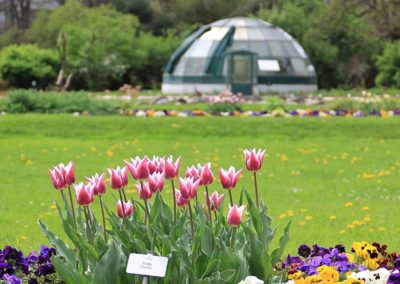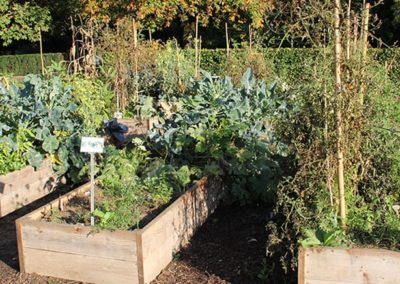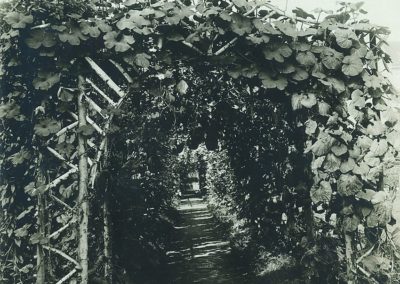
Annuals and Perennials
Plants that do not have woody stems above the ground are called herbaceous plants. They can be annuals, biennials and perennials. Annuals grow, flower and die completely within one growing season, and they then grow again from seed. The life cycle of biennials lasts throughout two years, and perennials live more than two years and may live even for decades. We are growing different groups of herbaceous plants; species and cultivars with decorative leaves, flowers and fruits, aromatic and medicinal plants and herbs, marsh plants, botanically interesting plants important for university studies, rare and endangered plants, crop-plants etc. Most of them require a lot of light and warmth to bloom, with the exception of sciophytes (shade plants), e.g. ferns and hostas (funkias).
The Fernarium
In this bed (P32 in the arboretum) we are growing some of the most common species of true ferns belonging to the Croatian flora. The male fern (Dryopteris filix-mas) is one of the most common ferns of Croatian deciduous forests. The lady fern (Athyrium filix-femina) prefers shady, humid woods. The Common polypody (Polypodium vulgare) and the Southern polypody (P. cambricum) are two closely related fern species. The former, an evergreen, grows in the continental areas, while the latter, grows only in wintertime in the coastal region. Hart’s-tongue fern (Asplenium (Phyllitis) scolopendrium) is an unusual fern with narrow, elongated leaves that look like long ‘tongues’.
The Ostrich fern (Matteucia struthiopteris), a rare species of the Croatian flora, has two types of fronds. In early spring, it sprouts brown shoots that carry spores, while the green, sterile fronds appear later. The Hard Shield fern (Polystichum aculeatum) and the Soft shield fern (P. setiferum) are known as horticultural plants. Along with the domestic species grown outdoors, we grow a number of (sub)tropical species in the greenhouses, which are, during the summertime, placed in the open.
The hosta garden – Hostarium
As relative newcomers to horticulture in the West, the hostas or funkias (Hosta: Asparagaceae or Liliaceae family) started being widely cultivated in the 1920s. They were introduced to the scientific community by the famous Swedish botanist and student of Linnaeus, Carl Peter Thunberg (1743 – 1828). He spent his working years in the Far East and earned the title of the ‘father of the Japanese flora’. The wild hosta species (about 40) are slow-growing, long-lived plants, originating mainly from eastern Japan. They dislike frequent disturbance such as transplanting, replanting or any significant changes in their environment (e.g. removal of the tree that was providing a shade for decades). For this reason, a number of fast-growing cultivars, adapted to almost any type of soil, have been bred to satisfy those who look for immediate results. Some of these cultivars have marbled, shiny or bi-coloured leaves, and flowers ranging from rose to violet. You will understand just how popular the hostas are in botanical gardens if we tell you that more than 3,000 hybrids and cultivars have been registered. In this flower bed, we are growing about 15 of them. The dwarf or mini-hostas with their curled leaves and big flowers (Hosta ‘Univittata Undulata’) and the giant hostas with waxy leaves (H. ‘Fortunei Gigantea’) are particularly beautiful.
The parterre
The Floral parterre occupies the central part of the Botanical Garden. It is an open space originally designed in the French style (jardin à la française). A parterre is a garden formed on a flat surface, composed of regularly shaped, strictly symmetrical flowerbeds, separated and connected by equally symmetrical gravel-covered paths. The beds may or may not contain flowers and they are encircled by stone curbs or geometrically trimmed low hedges. The parterre gardens are mostly built close to the tall buildings because their regular design, which is intended to be admired more than the plants it contains, is best perceived from above. The parterre in our Garden predominantly includes flowers, mainly perennial and annual plants, and it is very modest in size. The best way to truly experience the beauty of the parterre and its central, nicely-trimmed lawn curbed by symmetrically arranged flowerbeds is by viewing it from the elevation in front of the exhibition greenhouse. Decorative herbaceous perennials are grown in the inner flowerbeds. Twice a year, various annuals are planted around them to produce spring and summer aspects. In the outer beds, rose cultivars from the Rosa Floribunda and Rosa Polyantha groups have been cultivated for a number of years now.
Basins with fountain
Built in 1891 for the purpose of growing water lilies, they were renovated in 2005 in order to restore their original design. At the end of the 20th century, a small dome-shaped greenhouse (Victoria’s house) was built, including a basin for growing tropical marsh plants.
For decades, several cultivars of hardy water lilies with red, yellow and pink flowers (Nymphaea x marliacea ‘Rubra’, ‘Chromatella’ and ‘Rosea’) have been successfully grown in the pools around the water fountain. The sacred lotuses (Nelumbo nucifera) are most prominent in August, with their large pink flowers and bluish green shield-shaped leaves raised high above the water surface. This beautiful perennial is native to south Asia and Australia. The Buddhists treat it as sacred, hence the common name. The powdery thalia (Thalia dealbata), native to warm North American areas, bloom in the same pool during the summer. The whole plant looks as if it is sprinkled with a whitish powder. Thalias and Sacred Lotuses successfully survive winters in the pool, protected against the cold and frost under a cover of dry leaves. In the outer beds, encircling the basins, the different rose cultivars and ‘bearded’ iris cultivars are planted.
The small lakes
The lakes with a bridge have been parts of the Botanical Garden since its very beginnings. They were envisaged in the original design plans dating from 1889. The first bridge over the lakes was probably built in 1892, and, since that time, it has been redesigned at least five times. The present-day bridge, designed according to the photos from the 19th century, is most similar to the original one. Many visitors, stop at the bridge to take in the view, while many older citizens of Zagreb still remember with nostalgia their walks across the bridge and alongside the small lakes taken with their parents even before the Second World War. Today, the bridge is still the most favorite part of the Garden for our youngest ones where they enjoy watching the fish, frogs, turtles and ducks, often accompanied by their ducklings in springtime. At the beginning of the 20th century, White Storks could often be seen by the small lakes. Today, the lakes are sometimes visited by Mute Swans or Grey Herons. The water lilies and lotuses, the most beautiful green inhabitants of the small lakes, were ‘eternalised’ at the turn of the 20th century by master aquarellist Slava Raškaj (1877-1906). Various swamp plants grow alongside the lakes, while the flower beds contain ornamental perennials and annuals. Various species and cultivars of popular annual plants such as zinnias (Zinnia spp.), honeycombs (Tagetes spp.) and wax begonias (Begonia semperflorens cult.) are all regular summer residents of the ornamental flower beds surrounding the small lakes, as are the various species and cultivars of perennials such as larkspurs (genus Delphinium) and ornamental columbines (genus Aquilegia), both belonging to the buttercup family (Ranunculaceae). Together with the surrounding beds, paths and the bridge, the small lakes were extensively reconstructed during preparations for the first University Games in Zagreb in 1987 and we continue to make small improvements.
Some of annuals and perennials regularly planted alongside the lakes belong to genera such as; zinnias (Zinnia), marigolds (Tagetes), summer begonias (Begonia Semperflorens cult.), spider-flowers (Cleome), larkspurs (Delphinium) and columbines (rod Aquilegia).
The systematic field
Planned and planted in 1954 and 1955, it is mainly intended for students of systematic botany. It consists of three major parts: the monocot section (Monocotyledones), the dicot section (Dicotyledones) and 58 small basins in between with aquatic and swamp plants. The flowerbeds are arranged according to systematic categories, i.e. families, genera and species. The students can learn what the plants look like in different seasons and in different stages of their life cycles, including seeds, blossoms and fruits. Many spring flowers like the Lily of the Valley (Convallaria majalis), many daffodils (Narcissus spp.), utilitarian plants (e.g. Common Hop, Humulus lupulus) and a collection of bulbous species are grown here. Among the dicots, the most abundant ones are the members of the buttercup (Ranunculaceae), rose (Rosaceae), carrot (Apiaceae), mustard (Brassicaceae), pink (Caryophyllaceae), potato (Solanaceae), mint (Lamiaceae) and daisy (Asteraceae) families. The lily (Liliaceae), amaryllis (Amaryllidaceae), iris (Iridaceae), sedge (Cyperaceae) and grass (Poaceae) families represent the monocots.
The Marsh plants that are growing in the Croatian swamps are planted in several locations in the Botanical Garden: in two small artificial lakes and the basins within the systematic field. Due to drying and pollution of humid habitats, particularly swamps, which were considered undesirable until the 1960s, many wetland plants and animals around the world became endangered. In order to increase our collection of wetland species in the Botanical Garden, the small swamp was built in 2011. Here, a number of plant species that do not grow together in the natural environment were planted together, for example, Water clover (Marsilea quadrifolia), Bogbean (Menyanthes trifoliata), Lanceleaf water plantain (Alisma lanceolatum), Flowering rush (Butomus umbellatus), Bog arum (Calla palustris), and other species.
The collection of medicinal and spice herbs has gradually been regenerated and extended since 2007. However, it has been in this location since the Garden was first established. The cultivation of medicinal plants dates back to ancient history. The most numerous specimens in our modest collection are the various species of sage (Salvia spp.). However, since many of the species come from the warmer climates, some sages (Salvia mexicana, S. canariensis, S. algeriensis) do not thrive here because the high soil humidity in winter does not suit them. The collection, which may change with the seasons, includes various well-known spice plants. Sometimes we grow Common Parsley (Petroselinum crispum), Chives (Allium schoenoprasum), Field Marigold (Calendula arvensis), Sweet Basil (Ocimum basilicum) or Caraway (Carum carvi), together with some less known species, like Chilli Pepper (Capsicum frutescens ‘Peruvian Purple’).
In front of the Exhibition pavilion two small flower ornaments were originally arranged as the apothecary gardens in 2007. After planting medicinal and spice herbs within the Systematic filed, we started arranging these ornaments with flowering annuals and perennials, usually with apposite colours celebrating the events like the accession of the Republic of Croatia to the European Union or the Gardens 125th birthday.
The flower spectrum
These flower beds in the colours of the rainbow were created by the conversion of former nurseries. At the end of the 1960s, when the idea of a new botanical garden in Zagreb on the slopes of Medvednica was being seriously discussed, a nursery was built in this location to ensure enough space for cultivation of the base stock of various ornamental plants, which would later be transplanted into that long-awaited, new garden. The decades passed, the new botanical garden was never built and the spacious nursery with more than 500 ornamental herbaceous plant species remained inaccessible to the general public. For this reason, the larger part of the nursery was converted in 2008 and opened to the visitors. In order to make the plot more interesting, the flower beds were arranged in the shape of a ‘floral rainbow’. These include perennials planted according to the colour of their flowers (rarely fruits or leaves), around which an edge of annual plants is planted every year. In this way, the flowerbeds imitate the spectrum composed of six pure colours: red, orange, yellow, green, blue and violet. At one end of this flower spectrum there is a multi-coloured bed where a collection of irises dominate in May, while on the other end, there is a bed of white-flowered plants. The information boards next to the flower beds provide information about the meaning of the colours, how the colours are perceived by the pollinators as well as numerous other curiosities
The last flower bed of the Flower spectrum is planted with a small collection of the so-called ‘tall bearded’ irises (Iris, cultivar group Barbata Elatior), which will enchant you with their colourful flowers in May. The irises of this taxonomic group have large flowers, conspicuously coloured perianths grouped in inflorescences on long stalks. The richness of colour of the perianths of the ‘bearded irises’ is really inexhaustible. The perianths may be snow-white (Iris ‘Canadian Northland’, I. ‘Fuji’s Mantle’), single-coloured (yellow I. ‘Fox Fire’, blue I. ‘Royal Regency’, brownish-red I. ‘Fort Apache’), bi-coloured (I. ‘High Command’, I. ‘Pink Plum’, I. ‘Acrobat’), multi-coloured (I. ‘Collage’, I. ‘Sweet Musette’, I. ‘Queen in Calico’) and even fully black (dark violet I. ‘Before the Storm’ or I. ‘Swazi Princess’).
The collection grew over the decades, thanks to exchange with other European botanical gardens (e.g. Pruhonice, Czech Republic) and gifts from visitors and colleagues (e.g. from the nursery in Hamilton, Canada). Today we have about 80 cultivars of ornamental irises belonging to the Barbata Elatior group and about as many species, cultivars and hybrids of the large genus Iris. This flower bed also hosts a number of ‘pure species’ of irises, i.e. wild cultivars of which some were taken from their natural habitats, and some grown from the seeds.
The Peony garden
The peonies are flowering plants in the genus Paeonia, the only one in the family Paeoniaceae. They are native to Asia, Europe and Western North America. Depending on the views of a particular peony-specialist, the number of species range from 25 to 40.
Most peonies are herbaceous perennials, but some are woody shrubs. Their large, often fragrant flowers appear in late spring and early summer. Peonies can be purchased in many nurseries, in a large variety of heights, as well as colours and shapes of flowers. They are mostly winter-resistant and long lived.
In this small Paeoniarium we grow several different peony species and cultivars, mostly raised from seeds. These are herbaceous peonies; their green parts completely die off in late autumn and new leaves grow in spring. The tree peonies also lose their leaves, but the wood twigs remain above the ground during cold months. We are also growing several tree peonies in the small flower bed in the P2, near the main entrance.
The School garden
Adjacent to the Peony garden is a small School (Children’s) flower and vegetable Garden arranged in 2013 with the idea to give the children growing up in urban areas the opportunity to grow plants. The children from the nearby primary school and kindergarten use the designated, fenced area to grow vegetables and flowers in an organic manner, assisted by their teachers and the botanists working in the Garden. They sow seeds, replant and transplant the seedlings, prepare the soil and plant young plants, as well as take care of them throughout the season until the autumn harvest. They also pull out the weeds and eliminate the parasites (without using pesticides or herbicides). The children take pride in being able to provide food, which they have grown themselves, for the school kitchen.
Climbers and vines
A shaded corridor (pergola) with a collection of climbers, was constructed around the basins and fountain in the Parterre in 1890s, but was lost until 1930s due to conversion of that space for other purposes. Today we grow climbers and vines in different places in the Garden, e.g. Dutchman’s pipevine (Aristolochia macrophylla), chocolate vine (Akebia quinata) and Virginia creeper (Parthenocissus quinquefolia). Annual climbers with interesting flowers are grown in sunny spots alongside the fences in the Parterre and the Flower spectrum, for instance species and cultivars of Morning glory, Clematis and Lablab.
A new southern fence in the shape of a pergola is planned and should be constructed in the following years, stretching from the pedestrian bridge in the east to the Crnatkova street in the west. It will be used for planting a large climber and vine collection.










































